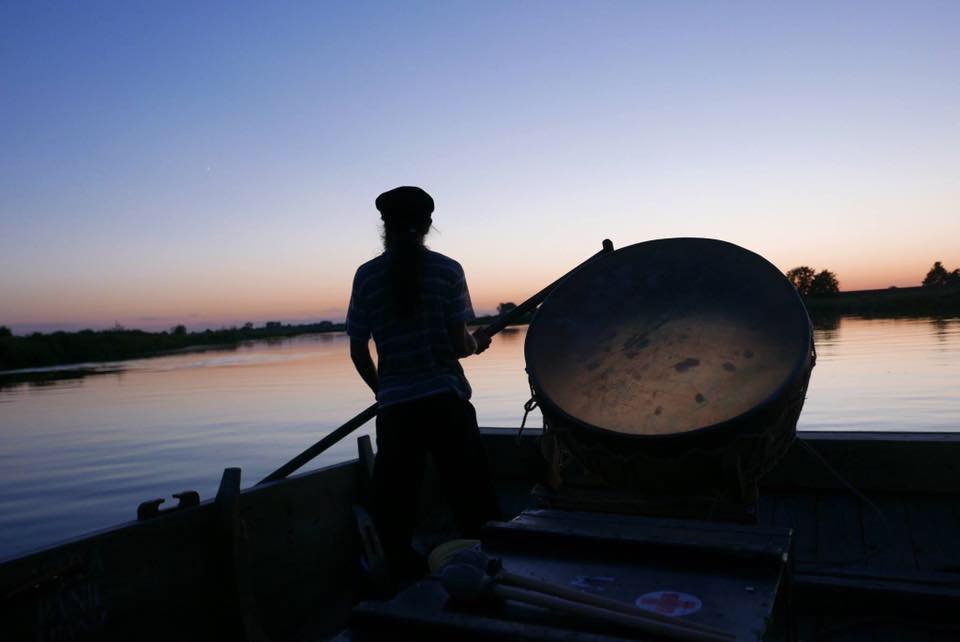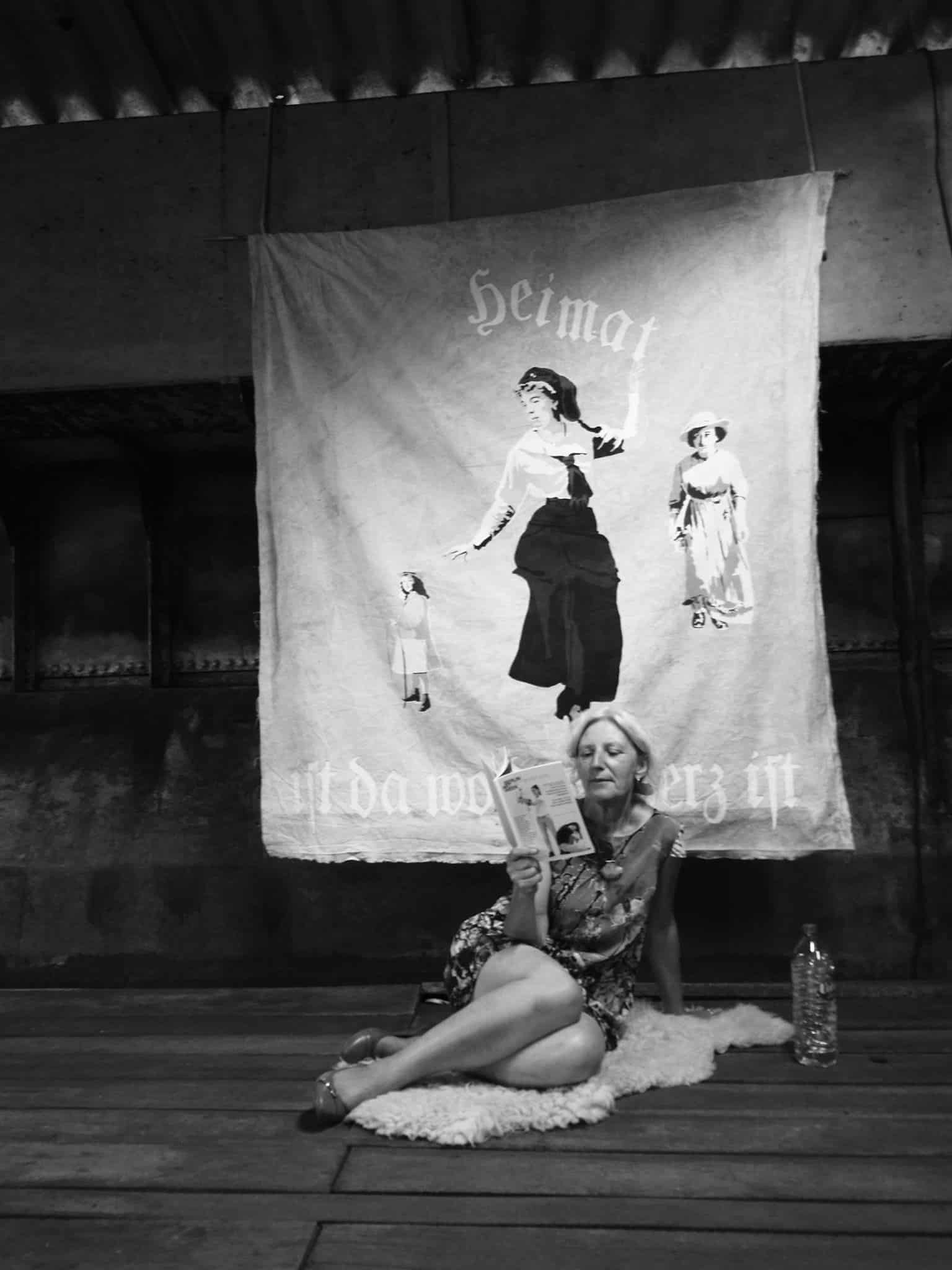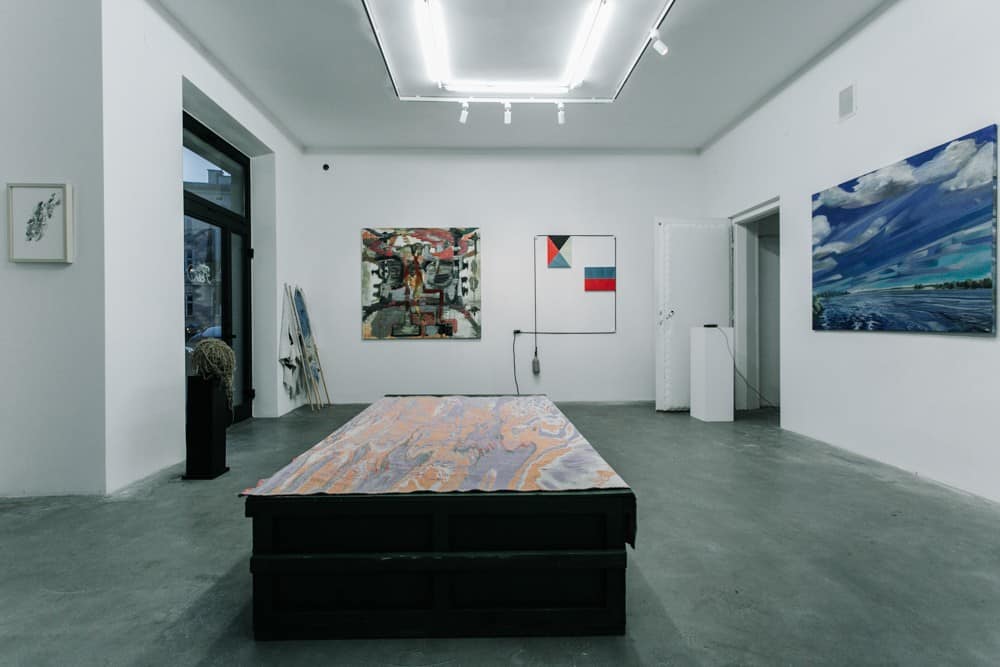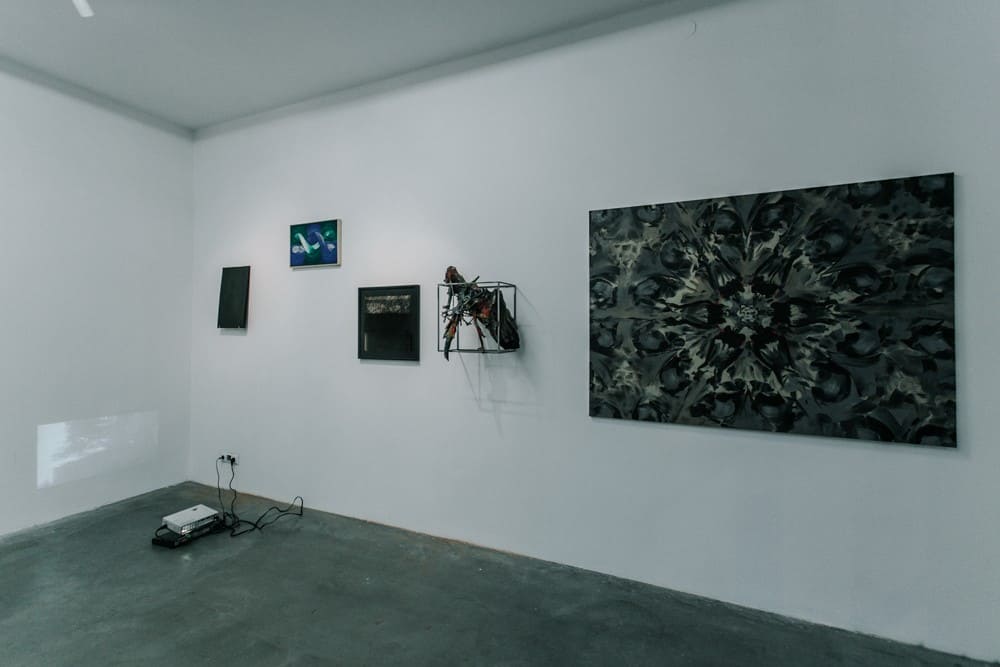“The Catfish Return or a Report from the Scene”
“Get me some hooks! I’d like to do some fishing,” A. uttered.
We were preparing a shopping list for the coming days and each could have their pick. A. wanted hooks, which were absent from our boat because we never fish and prefer a vegetarian diet. However, on our boat we agreed to have no strict rules and to accommodate new situations.
We floated down the river from Gdańsk on a wooden scow, under the flag of the Earth, and stopped opposite the town of Ciechocinek on a river island called Kępa Zielona (Green Clump). It was once inhabited by humans, but now it’s a home only to wild animals. Its shores are overgrown with aspen, willow and juniper, while its interior is one large green meadow, bearing traces of roads and orchards.
We set up camp on the edge of the island. There was a patch of sand and some space for our tents and a bonfire. There was even a bathroom, which was separated from our camp by a sunken poplar tree with its branches desperately sticking up towards the sky. A pike lived in our bathroom, or some other guy; something always splashed and made ripples there.
The island was an ideal place for being in the open-air. We’d invited artists who joined us from all over the land. At least once a day our boat ferried someone to or from the riverbank. We were a party of eleven: A., A. & A., E., M., K. & L. as well as B., K., M. & M. We were picking up another group: B. with his son F. and I. from Kenya, who had just flown into Poland for the first time, when a man called The Devil appeared.
“Wanna buy a fish?” he asked. We hesitated, but our curiosity won, especially as we had no hooks to fish.
“A large one!” he added. We would never have guessed that it might be too large for a party of fourteen.
We soon saw it: a catfish, still alive, but with very little chance of survival. Two men carried him; the fishing line threaded through his gills behind the head. We were shocked. We thought little of eating by then, wanting only to end his plight. The purchase was made and they dropped him on board.
He lay there occupying some two metres, the whole width of the prow.
We doubted he could survive. We ferried him back to the island and killed him there, on the boat. His blood flowed; we collected it and washed the boards clean. The air was filled with the smell of fresh gore. We were excited, determined, sad. It was a sacrifice. An unexpected, enforced covenant irrevocably connecting us to something.
A. felt responsible for the fish and devoted herself to his dressing. She portioned his large body with considerable effort. Our every pail and bowl was filled with catfish meat. That night we roasted it over the fire. We kept our vigil until sunrise. We communed with the visible and the invisible. We wanted to learn everything about him: he was a predator from the top of the food chain, feeding on fish, birds and small mammals, or even dogs. Judging by his looks and weight, he must have been quite old, 20 years, maybe more. We were eating him for the next three days, variously seasoned, and then we carried on upstream. It was lovely, as always on the Vistula, but somewhere deep inside…
A few days later we were passing by Wyszogród. There I always meet E., who lives in an old fisherman’s house, near the harbour. I looked around but couldn’t find him.
He soon caught up with us in his dinghy. “I’ve got something for you,” he winked at us and threw a catfish on board. This one was lean, young, his small eyes could still see and his whiskers trembled gently.
E. turned back and headed towards an island to continue hunting. We put the catfish in a water-filled pail and kept going. We knew, without a word, what to do: around the bend we let him go back into the Vistula. Phew!
That night we settled around a bonfire on a sandy island. It was the start of the August full moon. All was well.
We set out in the morning and reached Kozienice a few days later. We wanted to investigate what was being built across the river. It was a concreted dam near the power station. We went a little farther upstream, towards a ferry that was close to the store where we wanted to do our shopping. A slipway, made of concrete slabs, had a catfish painted on it in blue.
The caption said: SUMA SUMARUM SUMA NIE MA. – ALL IN ALL THE CATFISH IS GONE.
A short story written by Ewa Ciepielewska. Translated by Piotr Mierzwa

European Float, Vistula-Loara, 2015, photo by Agnieszka Brzeżańska
In the era of environmental crises, social solidarity and activism seem to shape our existence and this new form of participation in society occurs largely through art and socially engaged projects. The river becomes a common starting point for the actions of artists, curators and social workers participating in art residences on the wooden boat on the Vistula. Flow/Przepływ is an attempt to refresh the concept of art by removing the idea of preconceived results and the need to produce objects; a method that seeks to preserve and protect cultural and natural heritage and one that acts as a therapy for minds polluted by information overload. The point of departure starts with a better understanding of common cognitive patterns that connect different forms of life and combining diverse registers of knowledge with the competence in creating descriptions, models and solutions for the common system. The project engages diverse communities, and is a response to contemporary life, its problems, gender and social inequalities, situations to which artists react and contribute towards potential solutions. The project revolves around the idea of intellectual, social and artistic exchange.

Vistula Festival in Torun, Poland, 2017, photo by Pan Tosz
It has been three years since the project was set in motion, and more than thirty artists have engaged with this process of exploring new ways of existence, the natural environment, activism and semiotics, where common signs are read in peculiar contexts: extra-linguistic, non-human and biological. What is the language of Flow anyway? Ewa Ciepielewska, by creating a system within a system, has achieved the most sophisticated form of deconstructing reality. For this purpose, she invented a method to explore the system from the inside without using any physical force to enable construction of a new system. Floating on the boat is one of these methods that Ciepielewska produced in her practice, changing patterns of reality and finding the solutions to change the reality. It always starts with her surroundings. Then it affects others as it happened to Agnieszka Brzeżańska who began collaborating closely with the artist in 2015. Since then she has been involved in creating the project along with Ewa Ciepielewska, and they invite artists, curators and creatives onto the boat between May and September every year.

Ewa Ciepielewska on Heimatland Berge in Berlin, Alter Hafen, Berlin, 2016, photo by Bell Etage
Thus, floating is a process that manifests in a production of alternative communities. This concept of a temporary community might be even perceived as a rebellion against the system and capitalism with its various aspects, mostly aggressive to sensitive minds and oppressive to the concept of the ‘other’; the stranger that does not fit in the contemporary society with its dilapidated structures. It does not even have to be a refugee, because we all on some level are abandoned or excluded. There is a chunk of society that thinks that some of the others are beneath them in the vertical structure of hierarchy. “No hierarchy!” It would seem that artists shouted from the bottom of their lungs benevolently. Flow is a truly peaceful response to what we all experience in this populist world and the politics of today; without using verbal and physical abuse artists are battling against the conditions that we live in: mendacity.
Flow is an alive manifesto, intense therapy, an experiment that leads to one goal: liberation. Like at the La Borde Clinique run by Félix Guattari, there is a flexibility in choosing patterns of behaviour or roles. It is free from any restrictions of who you are on the boat, or who you have to be. As a result, it is not the concept of producing new works that is essential but the process itself, the attempt to experiment.

Flow.The Catfish Return, Księgarnia/Wystawa, Kraków, installation view, photo by Grzegorz Mart
There’s nothing more liberating than the healing process of fire. Thus, in the middle of nowhere, on an uninhabited island, the bonfire’s light shines bright, illuminating the otherwise pitch-black surroundings. And when you finally have a moment to look at the glittering starry sky, you realise that you are merged with the whole universe, and there is no reason to turn back. You are with your ancestors – shamans exploring inner, above and beneath worlds.
You are singing the syllables, and it is more natural than language structures. Words do not exist. You are nature.
Written by Kola Sliwinska
Edited by Lisa Barham

Flow.The Catfish Return, Księgarnia/Wystawa, Kraków, installation view, photo by Grzegorz Mart
Artists: Iddi Bashir / Dobrawa Borkała / Agnieszka Brzeżańska / Anna Brzozowska / Ewa Ciepielewska / Joanna Duda / Łukasz Dybalski / Jakub Falkowski / Habima Fuchs / Sonia Ginelli / Jakub Gliński / Justyna Górowska / Adam Gruba / Olivier Guessele Garai / Zuzanna Hercberg / Elżbieta Jabłońska / Renata Kamińska / Tamás Kaszás / Izabela Koczanowska / Tomasz Kopcewicz / Maria Kozłowska / Kamil Kuitkowski / Katarzyna Kukuła / Anikó Loránt / Jarek Lustych / Luxus: Jerzy Kosałka, Małgorzata Plata, Pawel Jarodzki, Bożena Jarodzka, Szymon Lubiński / Antje Majewski / Cecylia Malik / Małgorzata Markiewicz / Bartek Materka / Karolina Mełnicka / Justyna Mędrala / Krzysztof Mężyk / Tomasz Mróz / Muzealne Biuro Wycieczkowe / Małgorzata Nierodzinska / Dominika Olszowy / Franciszek Orłowski / Tomek Pawłowski / Sławomir Pawszak / Katarzyna Przezwańska / Alicja Raczkowska / Karol Radziszewski / Alicja Rogalska / Szymon Rogiński / Mathilde Rosier / Helena Siemińska / Emilia Sobczuk / Kama Sokolnicka / Michał Szlaga / Stachu Szumski / Małgorza Szymankiewicz / Angelica Teuta / Maria Toboła / Krzysztof Topolski / Dorota Walentynowicz / Tomasz Wawak / Amanda Wieczorek / Luka Woźniczko / Xaver Wolski / Alicja Wysocka / Eva Vermandel / Patryk Zakrocki / Anna Zaradny.

European Float, Vistula-Loara, 2015, photo by Agnieszka Brzeżańska






